Hajime Suzuki
Robust Anomaly Detection in O-RAN: Leveraging LLMs against Data Manipulation Attacks
Aug 11, 2025Abstract:The introduction of 5G and the Open Radio Access Network (O-RAN) architecture has enabled more flexible and intelligent network deployments. However, the increased complexity and openness of these architectures also introduce novel security challenges, such as data manipulation attacks on the semi-standardised Shared Data Layer (SDL) within the O-RAN platform through malicious xApps. In particular, malicious xApps can exploit this vulnerability by introducing subtle Unicode-wise alterations (hypoglyphs) into the data that are being used by traditional machine learning (ML)-based anomaly detection methods. These Unicode-wise manipulations can potentially bypass detection and cause failures in anomaly detection systems based on traditional ML, such as AutoEncoders, which are unable to process hypoglyphed data without crashing. We investigate the use of Large Language Models (LLMs) for anomaly detection within the O-RAN architecture to address this challenge. We demonstrate that LLM-based xApps maintain robust operational performance and are capable of processing manipulated messages without crashing. While initial detection accuracy requires further improvements, our results highlight the robustness of LLMs to adversarial attacks such as hypoglyphs in input data. There is potential to use their adaptability through prompt engineering to further improve the accuracy, although this requires further research. Additionally, we show that LLMs achieve low detection latency (under 0.07 seconds), making them suitable for Near-Real-Time (Near-RT) RIC deployments.
Self-Adaptive and Robust Federated Spectrum Sensing without Benign Majority for Cellular Networks
Jul 16, 2025Abstract:Advancements in wireless and mobile technologies, including 5G advanced and the envisioned 6G, are driving exponential growth in wireless devices. However, this rapid expansion exacerbates spectrum scarcity, posing a critical challenge. Dynamic spectrum allocation (DSA)--which relies on sensing and dynamically sharing spectrum--has emerged as an essential solution to address this issue. While machine learning (ML) models hold significant potential for improving spectrum sensing, their adoption in centralized ML-based DSA systems is limited by privacy concerns, bandwidth constraints, and regulatory challenges. To overcome these limitations, distributed ML-based approaches such as Federated Learning (FL) offer promising alternatives. This work addresses two key challenges in FL-based spectrum sensing (FLSS). First, the scarcity of labeled data for training FL models in practical spectrum sensing scenarios is tackled with a semi-supervised FL approach, combined with energy detection, enabling model training on unlabeled datasets. Second, we examine the security vulnerabilities of FLSS, focusing on the impact of data poisoning attacks. Our analysis highlights the shortcomings of existing majority-based defenses in countering such attacks. To address these vulnerabilities, we propose a novel defense mechanism inspired by vaccination, which effectively mitigates data poisoning attacks without relying on majority-based assumptions. Extensive experiments on both synthetic and real-world datasets validate our solutions, demonstrating that FLSS can achieve near-perfect accuracy on unlabeled datasets and maintain Byzantine robustness against both targeted and untargeted data poisoning attacks, even when a significant proportion of participants are malicious.
Quantum Down Sampling Filter for Variational Auto-encoder
Jan 09, 2025Abstract:Variational Autoencoders (VAEs) are essential tools in generative modeling and image reconstruction, with their performance heavily influenced by the encoder-decoder architecture. This study aims to improve the quality of reconstructed images by enhancing their resolution and preserving finer details, particularly when working with low-resolution inputs (16x16 pixels), where traditional VAEs often yield blurred or in-accurate results. To address this, we propose a hybrid model that combines quantum computing techniques in the VAE encoder with convolutional neural networks (CNNs) in the decoder. By upscaling the resolution from 16x16 to 32x32 during the encoding process, our approach evaluates how the model reconstructs images with enhanced resolution while maintaining key features and structures. This method tests the model's robustness in handling image reconstruction and its ability to preserve essential details despite training on lower-resolution data. We evaluate our proposed down sampling filter for Quantum VAE (Q-VAE) on the MNIST and USPS datasets and compare it with classical VAEs and a variant called Classical Direct Passing VAE (CDP-VAE), which uses windowing pooling filters in the encoding process. Performance is assessed using metrics such as the Fr\'echet Inception Distance (FID) and Mean Squared Error (MSE), which measure the fidelity of reconstructed images. Our results demonstrate that the Q-VAE consistently outperforms both the Classical VAE and CDP-VAE, achieving significantly lower FID and MSE scores. Additionally, CDP-VAE yields better performance than C-VAE. These findings highlight the potential of quantum-enhanced VAEs to improve image reconstruction quality by enhancing resolution and preserving essential features, offering a promising direction for future applications in computer vision and synthetic data generation.
Security and Privacy of 6G Federated Learning-enabled Dynamic Spectrum Sharing
Jun 18, 2024



Abstract:Spectrum sharing is increasingly vital in 6G wireless communication, facilitating dynamic access to unused spectrum holes. Recently, there has been a significant shift towards employing machine learning (ML) techniques for sensing spectrum holes. In this context, federated learning (FL)-enabled spectrum sensing technology has garnered wide attention, allowing for the construction of an aggregated ML model without disclosing the private spectrum sensing information of wireless user devices. However, the integrity of collaborative training and the privacy of spectrum information from local users have remained largely unexplored. This article first examines the latest developments in FL-enabled spectrum sharing for prospective 6G scenarios. It then identifies practical attack vectors in 6G to illustrate potential AI-powered security and privacy threats in these contexts. Finally, the study outlines future directions, including practical defense challenges and guidelines.
Radio Signal Classification by Adversarially Robust Quantum Machine Learning
Dec 13, 2023Abstract:Radio signal classification plays a pivotal role in identifying the modulation scheme used in received radio signals, which is essential for demodulation and proper interpretation of the transmitted information. Researchers have underscored the high susceptibility of ML algorithms for radio signal classification to adversarial attacks. Such vulnerability could result in severe consequences, including misinterpretation of critical messages, interception of classified information, or disruption of communication channels. Recent advancements in quantum computing have revolutionized theories and implementations of computation, bringing the unprecedented development of Quantum Machine Learning (QML). It is shown that quantum variational classifiers (QVCs) provide notably enhanced robustness against classical adversarial attacks in image classification. However, no research has yet explored whether QML can similarly mitigate adversarial threats in the context of radio signal classification. This work applies QVCs to radio signal classification and studies their robustness to various adversarial attacks. We also propose the novel application of the approximate amplitude encoding (AAE) technique to encode radio signal data efficiently. Our extensive simulation results present that attacks generated on QVCs transfer well to CNN models, indicating that these adversarial examples can fool neural networks that they are not explicitly designed to attack. However, the converse is not true. QVCs primarily resist the attacks generated on CNNs. Overall, with comprehensive simulations, our results shed new light on the growing field of QML by bridging knowledge gaps in QAML in radio signal classification and uncovering the advantages of applying QML methods in practical applications.
Quantum-Inspired Machine Learning: a Survey
Sep 08, 2023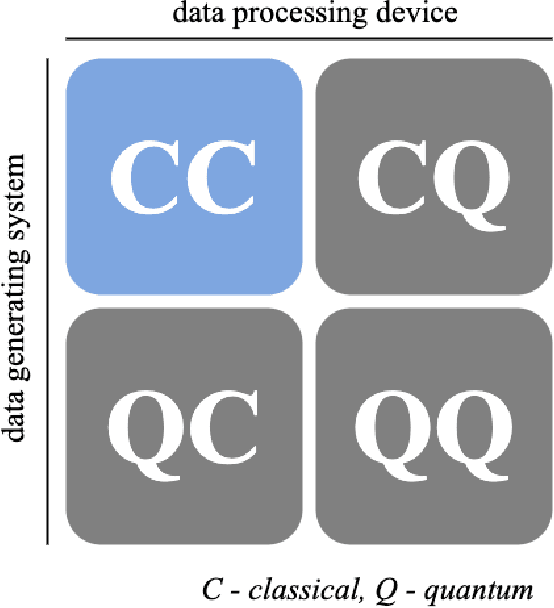
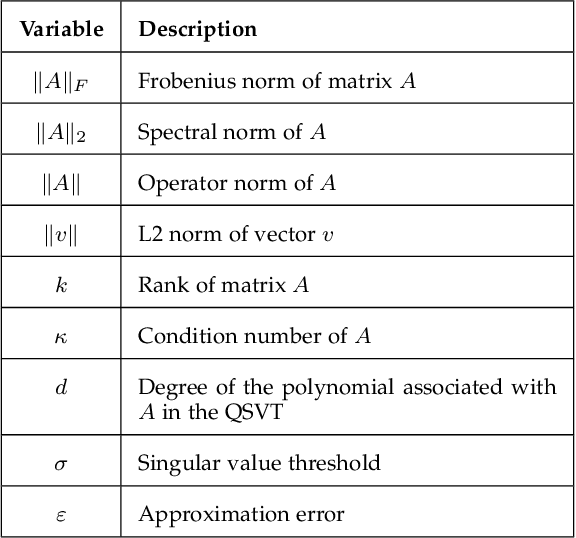
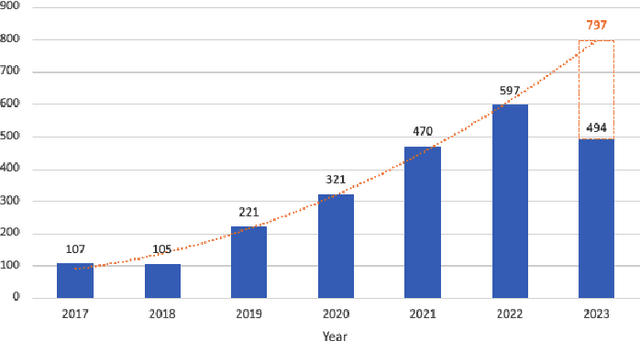
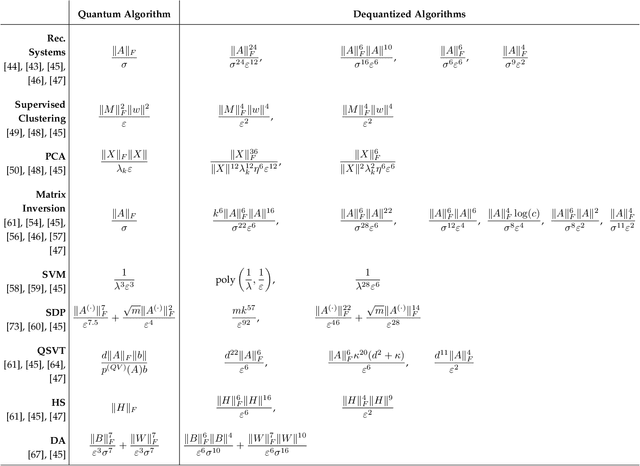
Abstract:Quantum-inspired Machine Learning (QiML) is a burgeoning field, receiving global attention from researchers for its potential to leverage principles of quantum mechanics within classical computational frameworks. However, current review literature often presents a superficial exploration of QiML, focusing instead on the broader Quantum Machine Learning (QML) field. In response to this gap, this survey provides an integrated and comprehensive examination of QiML, exploring QiML's diverse research domains including tensor network simulations, dequantized algorithms, and others, showcasing recent advancements, practical applications, and illuminating potential future research avenues. Further, a concrete definition of QiML is established by analyzing various prior interpretations of the term and their inherent ambiguities. As QiML continues to evolve, we anticipate a wealth of future developments drawing from quantum mechanics, quantum computing, and classical machine learning, enriching the field further. This survey serves as a guide for researchers and practitioners alike, providing a holistic understanding of QiML's current landscape and future directions.
Application of Quantum Pre-Processing Filter for Binary Image Classification with Small Samples
Aug 28, 2023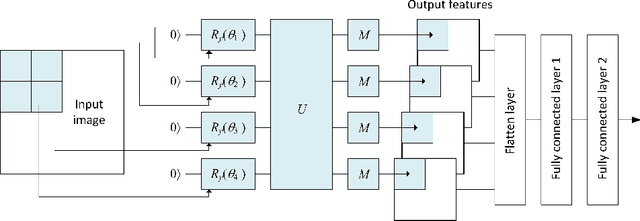

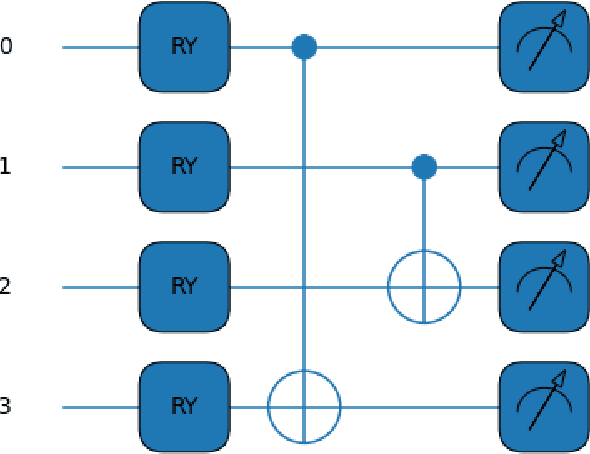

Abstract:Over the past few years, there has been significant interest in Quantum Machine Learning (QML) among researchers, as it has the potential to transform the field of machine learning. Several models that exploit the properties of quantum mechanics have been developed for practical applications. In this study, we investigated the application of our previously proposed quantum pre-processing filter (QPF) to binary image classification. We evaluated the QPF on four datasets: MNIST (handwritten digits), EMNIST (handwritten digits and alphabets), CIFAR-10 (photographic images) and GTSRB (real-life traffic sign images). Similar to our previous multi-class classification results, the application of QPF improved the binary image classification accuracy using neural network against MNIST, EMNIST, and CIFAR-10 from 98.9% to 99.2%, 97.8% to 98.3%, and 71.2% to 76.1%, respectively, but degraded it against GTSRB from 93.5% to 92.0%. We then applied QPF in cases using a smaller number of training and testing samples, i.e. 80 and 20 samples per class, respectively. In order to derive statistically stable results, we conducted the experiment with 100 trials choosing randomly different training and testing samples and averaging the results. The result showed that the application of QPF did not improve the image classification accuracy against MNIST and EMNIST but improved it against CIFAR-10 and GTSRB from 65.8% to 67.2% and 90.5% to 91.8%, respectively. Further research will be conducted as part of future work to investigate the potential of QPF to assess the scalability of the proposed approach to larger and complex datasets.
Development of a Novel Quantum Pre-processing Filter to Improve Image Classification Accuracy of Neural Network Models
Aug 22, 2023



Abstract:This paper proposes a novel quantum pre-processing filter (QPF) to improve the image classification accuracy of neural network (NN) models. A simple four qubit quantum circuit that uses Y rotation gates for encoding and two controlled NOT gates for creating correlation among the qubits is applied as a feature extraction filter prior to passing data into the fully connected NN architecture. By applying the QPF approach, the results show that the image classification accuracy based on the MNIST (handwritten 10 digits) and the EMNIST (handwritten 47 class digits and letters) datasets can be improved, from 92.5% to 95.4% and from 68.9% to 75.9%, respectively. These improvements were obtained without introducing extra model parameters or optimizations in the machine learning process. However, tests performed on the developed QPF approach against a relatively complex GTSRB dataset with 43 distinct class real-life traffic sign images showed a degradation in the classification accuracy. Considering this result, further research into the understanding and the design of a more suitable quantum circuit approach for image classification neural networks could be explored utilizing the baseline method proposed in this paper.
Heterogeneous Ground and Air Platforms, Homogeneous Sensing: Team CSIRO Data61's Approach to the DARPA Subterranean Challenge
Apr 19, 2021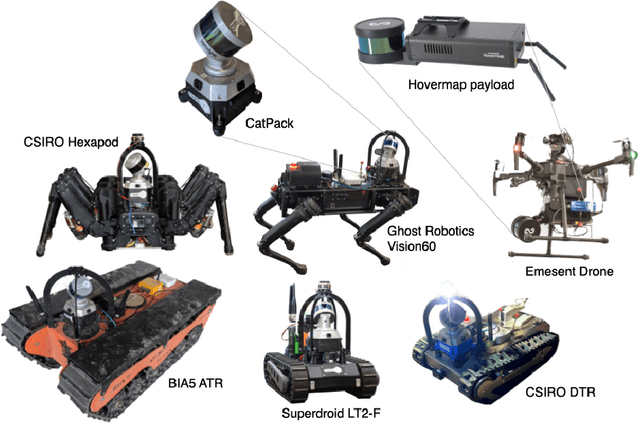


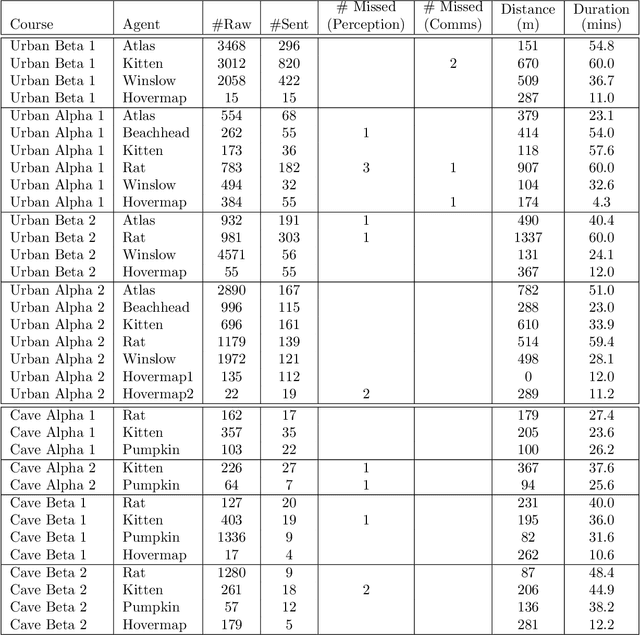
Abstract:Heterogeneous teams of robots, leveraging a balance between autonomy and human interaction, bring powerful capabilities to the problem of exploring dangerous, unstructured subterranean environments. Here we describe the solution developed by Team CSIRO Data61, consisting of CSIRO, Emesent and Georgia Tech, during the DARPA Subterranean Challenge. These presented systems were fielded in the Tunnel Circuit in August 2019, the Urban Circuit in February 2020, and in our own Cave event, conducted in September 2020. A unique capability of the fielded team is the homogeneous sensing of the platforms utilised, which is leveraged to obtain a decentralised multi-agent SLAM solution on each platform (both ground agents and UAVs) using peer-to-peer communications. This enabled a shift in focus from constructing a pervasive communications network to relying on multi-agent autonomy, motivated by experiences in early circuit events. These experiences also showed the surprising capability of rugged tracked platforms for challenging terrain, which in turn led to the heterogeneous team structure based on a BIA5 OzBot Titan ground robot and an Emesent Hovermap UAV, supplemented by smaller tracked or legged ground robots. The ground agents use a common CatPack perception module, which allowed reuse of the perception and autonomy stack across all ground agents with minimal adaptation.
 Add to Chrome
Add to Chrome Add to Firefox
Add to Firefox Add to Edge
Add to Edge